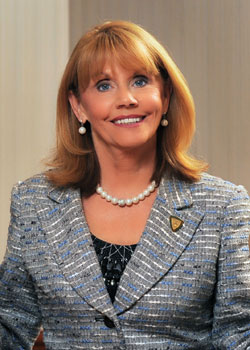Elizabeth Sheridan ’79 is transforming healthcare in the Garden State
Sheridan, COO of SJH Regional Medical Center corporate chief nursing executive of the SJH system, has proved a forceful advocate for nurses’ advancement within the profession and in governance.

Elizabeth Sheridan ’79, COO of SJH Regional Medical Center (pictured below) and corporate chief nursing executive of the SJH system, has been a forceful advocate for nurses’ advancement.

When she was recruited by South Jersey Healthcare (SJH) in 1999 to help create a new regional medical center, Elizabeth Sheridan ’79 solicited input from a key hospital constituency on its design: fellow nurses.
“We mocked up patient rooms and asked the staff to come through to see how we could improve them, and we incorporated their ideas in our design decisions,” recounted Sheridan, who is now chief operating officer of SJH Regional Medical Center and corporate chief nursing executive of the SJH system. “Our goal was to create a patient-centric environment.”
As hospital personnel who are “primarily responsible for patient assessment, care planning and coordination, and ensuring quality of care and patient satisfaction,” as Sheridan puts it, there are no more reliable authorities on patient services than nurses. Many of the system’s distinctive features—its well-designed private rooms, room service, and improved patient flow—stem from their recommendations.
Sheridan, who began her career in healthcare as a critical care nurse, has proved a forceful advocate for nurses’ advancement within the profession and in governance. Within her own organization, where she is responsible for setting an overall vision, developing strategic initiatives, and providing clinical leadership, she has created mechanisms for including their ideas on care policy on an ongoing basis. There are nursing representative on the system’s councils for quality, policy, equipment, and professional development who provide leadership to the organization.
Under her, SJH has earned Magnet designation from the American Nurses Credentialing Center for the quality of its patient care, nursing excellence, and innovations in nursing practice. All four of its ICUs have received the American Association of Critical Care Nurses’ Beacon Award for excellence.
“Nurses have always made great administrators. They’re team leaders—always managing dynamic situations while balancing time and resources—who have a sensitivity to those around them,” she says, noting their increasingly central role in the country’s evolving healthcare system. “They’re at the heart of primary care, and we’re seeing their role expand. Advanced
Practice Nurses are working in collaboration with physicians, and for many patients who do not have access to physicians, nurses are providing that care.”
She advocates for systemic healthcare reforms to reflect these realities through New Jersey’s Action Coalition, an organization created to implement recommendations around nursing education, training, and leadership from the Institute of Medicine’s 2010 report, The Future of Nursing: Leading Change, Advancing Health. As a co-chair of the group’s practice workgroup, Sheridan backs legislation and regulations that ensure nurses are working at all levels within healthcare and to the full extent of their training and education.
She urges nurses to earn advanced educational degrees, while crediting TCNJ with “instilling in me a sense of professionalism and reinforcing my desire to be a leader in nursing. After I graduated, there was no question that I would move on to a master’s program.”
She also calls on college administrators to help nurses along this path with programmatic changes that will help them make the jump to the next level.
“We need to smooth the track for nurses moving from associate’s degrees to bachelor’s degrees to master’s degrees. I encourage deans of BSN programs to better align their courses with associate programs,” she says. “I also talk to LPNs in those programs about what classes they need to take and how to move on to bachelor’s programs.”
Sheridan had been a critical care nurse for more than a decade when she briefly thought about giving it up. Free to pursue other career opportunities, she weighed factors such as schedule and pay, while wondering whether the field would satisfy her professional ambitions.
“I did a lot of soul searching,” she recalled. “And then I realized it was exactly what I wanted. I love nursing. It’s who I am. The nursing philosophy—the holistic approach, the focus on proactive and preventive care, the way it lends itself to team-building—resonates with me.”
 She determined, however, to move into leadership ranks to have a greater impact on her profession and patient care more broadly. In her first administrative post, as assistant director of nursing for a medical center in central New Jersey, she said it became clear why the ability to affect policy would be so critical. Responsible for recruitment during the nursing shortage in the 1970s, she listened carefully as nurses talked about workplace conditions that elicited their loyalty and best work. She would go on to implement many of them.
She determined, however, to move into leadership ranks to have a greater impact on her profession and patient care more broadly. In her first administrative post, as assistant director of nursing for a medical center in central New Jersey, she said it became clear why the ability to affect policy would be so critical. Responsible for recruitment during the nursing shortage in the 1970s, she listened carefully as nurses talked about workplace conditions that elicited their loyalty and best work. She would go on to implement many of them.
Healthcare institutions that succeed in attracting top-notch staff and keeping them have an appreciation for the balance between work and home life and create a work environment “that allows nurses to take great care of their patients and also spend quality time at home,” says Sheridan, who has been praised by fellow professionals for providing nurses “autonomy and professionalism.”
In 2008, she won the Professional Recognition award from ONE/NJ, the Organization of Nurse Executives in New Jersey, and in 2009, Nursing Spectrum magazine awarded her the Nursing Excellence Award for the Tri-State area.
In naming her Woman of the Year in 2010, Garden State Woman magazine credited Sheridan with “transforming the health of Cumberland County residents while establishing nursing as a leader in the effort to better patient care.” The publication cited her many successful initiatives—from increasing access to care for minority patients and improving their rates of congestive heart failure, to creating the Women’s Health Institute to address the needs of women, to establishing services to reduce teen pregnancy rates—as products of this vision.
Posted on November 27, 2012

